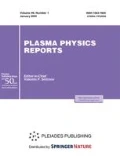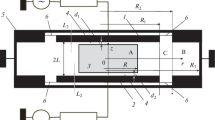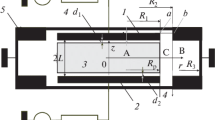Abstract—
Electrodynamic properties of a low-pressure (electron collision frequency much lower than the field frequency) capacitive high-frequency (HF) discharge with large-area electrodes maintained by an electromagnetic field with frequency higher than 13 MHz is studied analytically. The discharge is sustained by surface waves propagating along the plasma–space-charge sheath–metal interface. When describing the sheath, dispersion curves for even and odd surface waves in a three-layer structure (sheath–plasma–sheath) surrounded by metal boundaries are calculated within the framework of the matrix model. It is demonstrated that the field of the fundamental mode (the quasi-TEM mode) must be taken into account for correct discharge impedance calculation in the case of low electron densities, while the field of the surface wave must be taken into account in the case of high electron densities. An approximate expression governing the discharge impedance that is based on accounting only for one mode is derived. The expression is valid at low electron densities when the surface waves are absent, as well as high electron densities exceeding the value giving rise to a geometric resonance in the plasma–sheath system.











Similar content being viewed by others
Notes
Equations (12) and (13) are written in the form convenient for surface waves dispersion calculation. Their analogs for decaying waves can be easily obtained from (12) and (13) by making the following substitutions: \(p \to i\tilde {p}\), \({\text{tanh}}\left( {i\tilde {p}{{L}_{2}}} \right) \to i{\text{tan}}\left( {\tilde {p}{{L}_{2}}} \right)\), \(i\tilde {p}{\text{tanh}}\left( {i\tilde {p}{{L}_{2}}} \right) \to - \tilde {p}{\text{tan}}\left( {\tilde {p}{{L}_{2}}} \right)\), \({{{\text{tanh}}\left( {i\tilde {p}{{L}_{2}}} \right)} \mathord{\left/ {\vphantom {{{\text{tanh}}\left( {i\tilde {p}{{L}_{2}}} \right)} {i\tilde {p}}}} \right. \kern-0em} {i\tilde {p}}} \to {{{\text{tan}}\left( {\tilde {p}{{L}_{2}}} \right)} \mathord{\left/ {\vphantom {{{\text{tan}}\left( {\tilde {p}{{L}_{2}}} \right)} {\tilde {p}}}} \right. \kern-0em} {\tilde {p}}}\), \(h \to i\tilde {h}\), \({{J}_{n}}\left( {ihr} \right) \to {{i}^{n}}{{I}_{n}}\left( {\tilde {h}r} \right)\). Therefore, as a rule, the corresponding expressions for the decaying waves will not be presented due to them being rather cumbersome.
REFERENCES
M. A. Lieberman and A. J. Lichtenberg, Principles of Plasma Discharges and Materials Processing (Wiley, New York, 2005).
G. F. Ivanovskii and V. I. Petrov, Ion-Plasma Materials Processing (Radio i Svyaz’, Moscow, 1986) [in Russian].
J. Taillet, Am. J. Phys. 37, 423 (1969).
V. A. Godyak, Sov. J. Plasma Phys. 2, 78 (1976).
V. L. Ginzburg, The Propagation of Electromagnetic Waves in Plasmas (Nauka, Moscow, 1967; Pergamon, Oxford, 1970).
A. F. Aleksandrov, L. S. Bogdankevich, and A. A. Rukhadze, Principles of Plasma Electrodynamics (Vysshaya Shkola, Moscow, 1978; Springer-Verlag, Berlin, 1984).
P. Leprince, G. Mattieussent, and W. P. Allis, J. Appl. Phys. 42, 4 (1971).
S. Samukawa, M. Hori, S. Raul, K. Tachibana, P. Bruggeman, G. Kroesen, J. C. Whitehead, A. B. Murphy, A. F. Gutsol, S. Starikovskaia, U. Kortshagen, J.‑P. Boeuf, T. J. Sommerer, M. J. Kushner, U. Czarnetzki, et al., J. Phys. D: Appl. Phys. 45, 253001 (2012).
K. S. Collins, C. A. Roderick, S.-L. Yang, D. N. K. Wang, and D. Maydan, US Patent No. US5210466A (May 11, 1993).
H. Schmidt, L. Sansonnens, A. A. Howling, Ch. Hollenstein, M. Elyaakoubi, and J. P. M. Schmitt, J. Appl. Phys. 95, 4559 (2004).
E. Kawamura, M. A. Lieberman, and D. B. Graves, Plasma Sources Sci. Technol. 23, 064003 (2014).
A. Perret, P. Chabert, O.-P. Booth, J. Jolly, J. Gulion, and Ph. Auvray, Appl. Phys. Lett. 83, 243 (2003).
T. Ohiwa, H. Hayashi, I. Sakai, A. Kolma, and E. Shinomiya, Jpn. J. Appl. Phys. 43, 6413 (2004).
H. H. Goto, H. D. Lome, and T. Ohmi, J. Vac. Sci. Technol., A 10, 3048 (1992).
Z. Chen, S. Rauf, and K. Collins, J. Appl. Phys. 108, 073301 (2010).
S. Sharma, N. Sirse, A. Sen, M. M. Turner, and A. R. Ellingboe, Phys. Plasmas 26, 103508 (2019).
S. Wilczek, J. Trieschmann, J. Schulze, E. Schuengel, R. P. Brinkmann, A. Derzsi, I. Korolov, Z. Donkó, and T. Mussenbrock, Plasma Sources Sci. Technol. 24, 024002 (2015).
S. Wilczek, J. Trieschmann, D. Eremin, R. P. Brinkmann, J. Schulze, E. Schuengel, A. Derzsi, I. Korolov, P. Hartmann, Z. Donkó, and T. Mussenbrock, Phys. Plasmas 23, 063514 (2016).
S. Sharma, N. Sirse, A. Sen, M. M. Turner, and A. R. Ellingboe, Phys. Plasmas 23, 110701 (2016).
T. Kitamura, N. Nakano, T. Makabe, and Y. Yamaguchi, Plasma Sources Sci. Technol. 2, 40 (1993).
S. Segawa, M. Kurihara, N. Nakano, and T. Makabe, Jpn. J. Appl. Phys. 38, 4416 (1999).
A. E. Park, B. U. Cho, and J. K. Lee, IEEE Trans. Plasma Sci. 31, 628 (2003).
J. Perrin, J. Schmitt, C. Hollenstein, A. Howling, and L. Sansonnes, Plasma Phys. Control. Fusion 42, B353 (2000).
J. Schmitt, M. Elyaakoubu, and L. Sansonnes, Plasma Sources Sci. Technol. 11, A206 (2002).
T. Mussenbrock, T. Hemke, D. Ziegler, R. P. Brinkman, and M. Klick, Plasma Sources Sci. Technol. 17, 025018 (2008).
S. E. Savas and R. W. Plavidal, J. Vac. Sci. Technol., A 6, 1775 (1988).
M. A. Liberman, J. P. Booth, P. Chabert, J. M. Rax, and M. M. Turner, Plasma Sources Sci. Technol. 11, 283 (2002).
K. A. Alshakami and S. Daniels, AIP Adv. 9, 035047 (2019).
S. M. Hwang, Thin Solid Films 587, 28 (2015).
D. J. Cooperberg, Phys. Plasmas 5, 862 (1998).
D. J. Cooperberg and C. K. Birdsall, Plasma Sources Sci. Technol. 7, 41 (1998).
S. A. Dvinin, A. G. Vologirov, V. B. Mikheev, and V. S. Sviridkina, Plasma Phys. Rep. 34, 688 (2008).
P. Chabert, J. Phys. D: Appl. Phys. 40, R63 (2007).
I. Lee, D. B. Graves, and M. A. Lieberman, Plasma Sources Sci. Technol. 17, 015018 (2008).
L. Sansonnens, A. A. Howling, and Ch. Hollenstein, Plasma Sources Sci. Technol. 15, 302 (2006).
M. P. Bachinski, Radio Corp. Am. Rev. 28, 111 (1967).
E. K. Miller, Radio Sci. 3, 1175 (1968).
M. L. Schiff and J. A. Fejer, Radio Sci. 5, 819 (1970).
P. Meyer, N. Vernet, and P. Lassudrie-Duchesne, J. Appl. Phys. 45, 700 (1974).
G. A. Hebner, E. V. Barnat, P. A. Miller, A. M. Paterson, and J. P. Holland, Plasma Source Sci. Technol. 15, 889 (2006).
W. Gekelman, M. Barnes, S. Vincena, and P. Pribyl, Phys. Rev. Lett. 103, 045003 (2009).
D. Sung, J. Woo, K. Lim, K. Kim, V. Volynets, and G.‑H. Kim, J. Appl. Phys. 106, 023303 (2009).
X. Xu, S.-X. Zhao, Yu.-Ru. Zhang, and Y.-N. Wang, J. Appl. Phys. 108, 043308 (2010).
D. Eremin, T. Hemke, R. P. Brinkmann, and T. Mussenbrock, J. Phys. D: Appl. Phys. 46, 084017 (2013).
E. Kawamura, M. A. Lieberman, and A. J. Lichtenberg, Phys. Plasmas 25, 093517 (2018).
S. A. Dvinin, V. A. Dovzhenko, and G. S. Solntsev, Sov. J. Plasma Phys. 8, 698 (1982).
S. A. Dvinin, S. A. Postnikov, G. S. Solntsev, and L. I. Tsvetkova, Sov. J. Plasma Phys. 9, 749 (1983).
Y. Yasaka, D. Nozaki, K. Koga, M. Ando, M. Yamamoto, N. Coto, N. Ishii, and T. Morimoto, Jpn. J. Appl. Phys. 38, 4309 (1999).
D. Bohm, The Characteristics of Electrical Discharge in Magnetic Fields (McGraw-Hill, New York, 1949), p. 77.
C. D. Child, Phys. Rev. (Ser. I) 32, 492 (1911).
I. Langmuir, Phys. Rev. 2, 450 (1913).
A. Perret, P. Chabert, J. Jolly, and J. P. Booth, Appl. Phys. Lett. 86, 021501 (2005).
H. M. Mott-Smith and I. Langmuir, Phys. Rev. 28, 727 (1926).
P. M. Chung, L. Talbot, and K. J. Touryan, Electric Probes in Stationary and Flowing Plasma: Theory and Applications (Springer-Verlag, New York, 1975).
J. G. Laframboise and J. Rubinstein, Phys. Fluids 19, 1900 (1976).
J. G. Laframboise, Report No. 100 (University of Toronto, Institute for Aerospace Studies, Toronto, ON, 1966).
M. A. Lieberman, IEEE Trans. Plasma Sci. 16, 638 (1988).
M. A. Lieberman, IEEE Trans. Plasma Sci. 17, 338 (1989).
U. Czarnetzki, Phys. Rev. E 88, 063101 (2013).
V. V. Nikol’skii and T. I. Nikol’skaya, Electrodynamics and Radio Wave Propagation (Nauka, Moscow, 1989) [in Russian].
L. B. Felsen, and N. Marcuvitz, Radiation and Scattering of Waves (Prentice-Hall, Englewood Cliffs, 1973).
L. A. Vainshtein, Electromagnetic Waves (Radio i Svyaz’, Moscow, 1990) [in Russian].
V. P. Silin and A. A. Rukhadze, Electromagnetic Properties of Plasmas and Plasma-Like Media (Gosatomizdat, Moscow, 1961; Gordon & Breach, New York, 1965).
V. A. Godyak, Sov. Phys.–Tech. Phys. 16, 1073 (1972).
I. D. Kaganovich, O. V. Polomarov, and C. E. Theodosiou, Phys. Plasmas 11, 2399 (2004).
I. D. Kaganovich, O. V. Polomarov, and C. E. Theodosiou, IEEE Trans. Plasma Sci. 34, 696 (2006).
O. V. Polomarov, C. E. Theodosiou, I. D. Kaganovich, D. J. Economou, and B. N. Ramamurthi, IEEE Trans. Plasma Sci. 34, 767 (2006).
V. A. Godyak and V. I. Kolobov, Phys. Rev. Lett. 79, 4589 (1997).
G. J. M. Hagelaar, Plasma Sources Sci. Technol. 17, 025017 (2008).
G. J. M. Hagelaar, Phys. Rev. Lett. 100, 025001 (2008).
Z. F. Ding, B. Sun, and W. G. Huo, Phys. Plasmas 22, 063504 (2015).
J. Triesmachmann and T. Mussenbrock, Plasma Sources Sci. Technol. 26, 024004 (2017).
I. D. Kaganovich, Phys. Rev. Lett. 89, 2065006 (2002).
M. M. Turner, J. Phys. D: Appl. Phys. 42, 194008 (2009).
T. Lafleur and P. Chabert, Plasma Sources Sci. Technol. 24, 044002 (2015).
T. Lafleur, P. Chabert, M. M. Turner, and J. P. Booth, Plasma. Sources Sci. Technol. 23, 015016 (2014).
T. Lafleur, Plasma Sources Sci. Technol. 25, 013001 (2016).
I. D. Kaganovich and L. D. Tsendin, IEEE Trans. Plasma Sci. 20, 86 (1992).
E. Kawamura, M. A. Lieberman, and A. J. Lichtenberg, Phys. Plasmas 21, 123505 (2014).
V. Vahedi, M. A. Lieberman, G. Dipiezo, T. D. Rognlien, and D. Hewett, J. Appl. Phys. 78, 1446 (1995).
K. C. Shaing and A. Y. Aydemir, Phys. Plasmas 4, 3163 (1997).
P. Ahr, E. Schungel, J. Schulze, Ts. V. Tsankov, and U. Czarnetszki, Plasma Sources Sci. Technol. 24, 044006 (2015).
Th. Wegner, C. Kullig, and J. Melchener, Plasma Sources Sci. Technol. 24, 044001 (2015).
J. Schulze, Z. Donkó, T. Lafleur, S. Wilczek, and R. P. Brinkmann, Plasma Sources Sci. Technol. 27, 055010 (2018).
M. Vass, S. Wilczek, T. Lafleur, R. P. Brinkmann, Z. Donkó, and J. Schulze, Plasma Sources Sci. Technol. 29, 026019 (2020).
P. S. Bulkin, S. A. Dvinin, and G. S. Solntsev, Vestn. Mosk. Univ., Ser. 3: Fiz., Astron. 23, 84 (1982).
A. V. Gurevich and A. B. Shvartsburg, Nonlinear Theory of Radio Wave Propagation in the Ionosphere (Nauka, Moscow, 1973) [in Russian].
I. P. Shkarofsky, T. W. Johnston, and M. P. Bachynski, The Particle Kinetics of Plasmas (Addison-Wesley, Reading, 1966).
P. K. Cibin, Plasma Phys. 22, 609 (1980).
V. V. Nikol’skii, Variational Methods for Inner Problems of Electrodynamics (Nauka, Moscow, 1967), p. 169 [in Russian].
S. G. Mikhlin, Variational Methods in Mathematical Physics (Nauka, Moscow, 1970; Pergamon Press, Oxford, 1964).
V. N. Ponomaryev and G. S. Solntsev, Sov. Phys.–Tech. Phys. 11, 1027 (1967).
A. N. Tikhonov and A. A. Samarskii, Equations of Mathematical Physics (Nauka, Moscow, 2004; Dover, New York, 2011).
J. A. Stratton, Electromagnetic Theory (McGraw-Hill, New York, 1941).
Author information
Authors and Affiliations
Corresponding authors
Additional information
Translated by I. Shumai
Appendices
ANALYSIS OF DISPERSION EQUATION FOR WAVES IN THE THREE-LAYER SYSTEM
Propagation constants of the waves, appearing in the above equations, calculation can be simplified by considering a plane problem, representing a structure infinite in the X0Z plane, that consists of three dielectric layers with dielectric permittivities ε1, εP, ε2, and thicknesses d1, 2L–d1–d2, d2, respectively, instead of a cylindrical one. The 0X axis is parallel to the direction of wave propagation, the 0Z axis is perpendicular to it, and the 0Y axis is perpendicular to the structure surface. The equivalence of these two approaches follows from the possibility of expanding a plane wave in cylindrical waves, as well as from the possibility of solving the above problem by the separation of variables method [93, 94] both in cylindrical and plane coordinate systems. The wave prorogation constant along the structure h is defined by the determinant of the system of equations describing field distribution along the 0Z axis, that depend only on this coordinate and are identical in both coordinate systems.
Electrodes made of metal are located at the boundaries of the structure of thickness 2L. It is convenient to choose the coordinate system in such a way that zero on the 0Z axis would be located at the medium point of the positive column, i.e., so that the plasma and sheath boundaries have coordinates –L2 and L2 (d1 is the thickness of the upper sheath, d2 is the thickness of the lower sheath, and 2L = 2L2 + d1 + d2). For an E-wave, equations (1), (3), and (4), with zero boundary conditions (2) for the radial electric field imposed at the walls in the discharge chamber, yield the following expressions governing the electromagnetic field:
in the upper sheath,
in plasma, and
in the lower sheath.
The relation between the amplitudes of symmetric and anti-symmetric modes in the surface wave, and the dispersion relation, follow from equalities of tangent components of the electromagnetic field:
The minus sign denotes the surface wave with a shorter wavelength, while the plus sign denotes the surface wave with a longer wavelength. Introducing variables \({{\tilde {p}}^{2}} = h_{ \pm }^{2} - {{k}^{2}}{{\varepsilon }_{P}}\), \({{p}^{2}} = {{k}^{2}}{{\varepsilon }_{P}} - h_{ \pm }^{2}\), \(a_{{1,2}}^{2} = h_{ \pm }^{2} - \) \({{k}^{2}}{{\varepsilon }_{{1,2}}}\), \(\tilde {a}_{{1,2}}^{2} = {{k}^{2}}{{\varepsilon }_{{1,2}}} - h_{ \pm }^{2}\), we have
Dispersion relation (12) follows from (A.4) and (A.5).
APPENDIX B
FIELD STRUCTURE OF THE SURFACE WAVE, HIGHER-ORDER MODES, AND WAVEGUIDE MODES
The following notations for cylindrical functions were used in Tables 1–3: \({{P}_{0}}(x) = {{J}_{0}}(x)\), \(H_{0}^{{(1)}}(x),H_{0}^{{(2)}}(x)\), \({{Q}_{0}}(x) = {{I}_{0}}(x)\), \({{K}_{0}}(x)\), \({{P}_{1}}(x) = {{J}_{1}}(x)\), \(H_{1}^{{(1)}}(x)\), \(H_{1}^{{(2)}}(x)\), and \({{Q}_{1}}(x) = {{I}_{1}}(x)\), \( - {{K}_{1}}(x)\). The notations for the propagation constant are \({{\tilde {h}}_{{n \pm }}} = i{{h}_{{n \pm }}}\), \({{\overset{\lower0.5em\hbox{$\smash{\scriptscriptstyle\frown}$}}{a} }_{{n + }}}\, = \,\pi (1{\text{/}}2\, + \,n){\text{/}}L\), \({{\overset{\lower0.5em\hbox{$\smash{\scriptscriptstyle\frown}$}}{a} }_{{n - }}} = (\pi n){\text{/}}L\), and \({{\overset{\lower0.5em\hbox{$\smash{\scriptscriptstyle\frown}$}}{h} }_{{n \pm }}} = \sqrt {\overset{\lower0.5em\hbox{$\smash{\scriptscriptstyle\frown}$}}{a} _{{n \pm }}^{2} - {{k}^{2}}} \).
Rights and permissions
About this article
Cite this article
Dvinin, S.A., Sinkevich, O.A., Kodirzoda, Z.A. et al. Features of Electromagnetic Field Excitation in a Capacitive HF Discharge. I. General Aspects. A Simple Model of Symmetric Discharge. Plasma Phys. Rep. 46, 1181–1204 (2020). https://doi.org/10.1134/S1063780X20120028
Received:
Revised:
Accepted:
Published:
Issue Date:
DOI: https://doi.org/10.1134/S1063780X20120028




